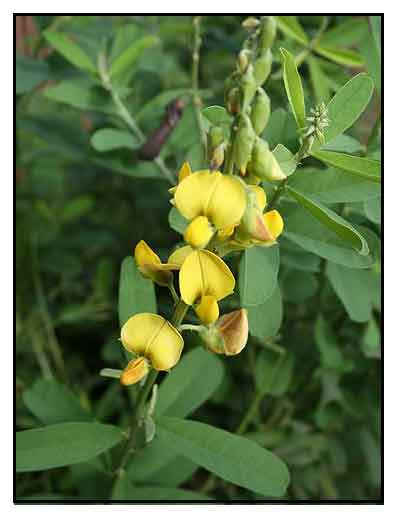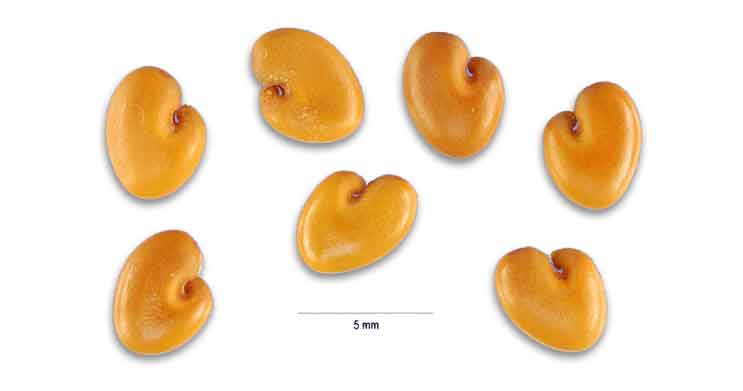 Botany Botany
Kalog-kalog is a half-woody plant growing to a height of 1 meter high. Leaves are alternate, simple, oblanceolate, 6 to 8 centimeters long, 2 to 2.5 centimeters wide, and with rounded ends. Pea flowers are yellow, arranged along a simple terminal flowering stalk (raceme) about 15 centimeters long. Fruits are inflated, smooth, cylindrical pods, 4 centimeters long and 1 centimeter wide, containing several, loose, flattened, black rounded seeds, 3 millimeters in diameter.
Distribution
- A common weed and a hindrance to cultivation and maintenance of orchards and plantations.
- Occasionally utilized as a cover crop and for green manuring.
Constituents
- Study of seeds yielded proximate values of moisture 15.00, fiber 37.50, ash 15.00, crude protein 4.37, oil 15.00, and carbohydrates 13.13%. (see study below) (3)
- Study isolated a pyrrolizidine alkaloid, monocrotaline.
- Phytochemical screening of leaf, stem, seed, pods and flowers yielded saponins, tannins, alkaloids, and sterols. Leaf showed highest concentration of phenols (67.35 ± 1.153 mg GAE/g of extract). (see study below) (17)
- Phytochemical screening of crude extract of leaves yielded alkaloid++, steroid++.
flavonoid+, tannin+, reducing sugar++, with an absence of saponin and phenol. (see study below) (18)
Properties
- Plant is nematode-resistant.
- Known as a butterfly host plant.
- Toxicity concern because of pyrrolizidine alkaloid content.
- Studies have suggested clastogenic, leishmanicide, antivenom, neurotoxic, antioxidant, clot lysis, antiproliferative, antimicrobial properties.
Parts used
Whole plant.
Uses
Edibility
- Flowers and leaves reportedly eaten as vegetable.
- In Vietnam, seeds are roasted and eaten.
Folkloric
- No reported folkloric medicinal use in the Philippines.
- In Ayurveda, plant vitiated kapha, vata, cough, dyspepsia, fever.
- Powdered seeds mixed with milk used for increasing body strength; also used for skin diseases.
- In Cameroon, plant used in the treatment of eczema.
- In Tamil Nadu, India, plant used for cough, dyspepsia, fever, cardiac disorders, stomatitis, diarrhea, scabies, impetigo.
- In Zaria, northern Nigeria, powdered plant mixed with roasted black caraway, taken in small quantities for stomach coli and flatulence. Squashed flowers with added potash, cooked into a soup, and taken for amenorrhea. For scabies, decoction of whole plant used for bathing.
- Roots used for hemoptysis.
- Leaves mixed with those of Crotalaria quinquefolia, consumed or applied externally for fever, scabies, lung afflictions, and impetigo.
- In Bangladesh, tribal people in the Chittagong Hill tracts use fresh juice and paste of leaves and seeds for skin diseases. (9)
- In India, seeds used for skin infection, constipation and pain. (10)
Others
- Fiber: Bark and stems are sources of strong fiber; used for cordage and making canvas. (17)
- Dye: In East Africa, used as dye plant. (17)
- Oil: Seed yields a non-edible, non-dryiing oil, with potential for use in making shampoo, creams, and shoe polish. (17)
- Livestock hazard: Poses a potential hazard to livestock because of pyrrolizidine alkaloid content.
 Studies Studies
• Clastogenic: Study of extracts from the fruits of Crotalaria retusa showed a dose-dependent increase in the frequency of chromosomal aberration in mice. No aberrant cells were seen with the leaf extracts. (2)
• Oil and Nutritive Value of Seeds: Study of seeds yielded proximate values of moisture 15.00, fiber 37.50, ash 15.00, crude protein 4.37, oil 15.00, and carbohydrates 13.13%. Oil showed to be non-drying and of low saturation. Saponification value implicated non-edibility, however, with use in production of shampoos, skin creams, and shoe polish. Its fairly high acid value suggested it required little purification to increase shelf-life.(see constituents above) (3)
• Leishmanicide: Study evaluated the cytotoxicity for procyclic promastigotes cells of Leishmania chagasi. Results showed cytotoxicity of EE at 10 and 30% for cells of Leishmania chagasi, an effect that might be associated only to the concentration of the alcohol present in the extract and not to the concentration of the plant in study. (4)
• Monocrotaline / Alkaloid / Neurotoxicity: Study showed MCT treatment caused changes on pattern of glial fibrillary acidic protein and ßIII-tubulin expression, with dose and time dependent intense down regulation and depolarization of neuronal tubulin. The cytochrome P450 enzyme system was involved in the MCT induced cytotoxicity in CNS cells. (5)
• Nematode Resistant: Plant is known to be nematode-resistant. Studies have found the dried plant parts can be worked into the soil as amendments to deter and reduce root galling by root-knot nematode, Meloidogyne incognita.
• Clastogenic Effects on Mouse Bone Marrow Cells: Study evaluated the clastogenicity of six extracts of leaves, tea, aqueous, and methanolic extracts of dried fruit and tea of unripe fruit. Extracts from fruits were shown to cause a dose dependent increase in the frequency of chromosomal aberrations in mice. The possibility that the pyrrolizidine alkaloid, monocrotaline, exerting a clastogenic effect on mouse bone marrow cells is discussed. (10)
• Monocrotaline / Pyrrolizidine Alkaloid: Study isolated one potent pyrrolizidine alkaloid, monocrotaline, from Crotalaria retusa. PAs (pyrrolizidine alkaloids) are toxic to humans and animals and known hepatotoxic, pnuemotoxic, genotoxic, neurotoxic, and cytotoxic. The structural elucidation of the toxic PAs provide a structure based in silico toxicological studies and modeling in drug design against various potent diseases in addition to estimation of pharmaceutical formulations. (11) Study evaluated three Crotalaria species viz. Crotalaia retusa, C. microcarpa, and C. naragutensis for alkaloids and its potential for toxicity.
Of the three, only C. retusa yielded unsaturated pyrrolizidine alkaloids. The alkaloids of C. retusa showed toxicity to albino Wistar rats, with marked microscopic hepatic lesions, along with significant toxic features in the lungs, kidneys, and intestines. Toxicity pattern was typical of alkaloid monocrotaline. (20)
• Role of Astrocytes in the Neurotoxicity of Monocrotaline: Review presented the main toxicological aspects of Crotalaria genus and recent findings on the mechanisms involved in the neurotoxic effects of MCT, which was extracted from C. retusa, and its interaction with neurons in isolated astrocytes. (13)
• Monocrotaline / Histological Damage and Oxidant Activity in Brain Areas of Mice: Study evaluated the effect of MCT in histopathological analysis of hippocampus (HC) and parahippocampal cortex (PHA) and in oxidative stress (OS) parameters in various brain areas. Lipid peroxidation was seen in all brain areas after administration of MCT. Monocrotaline caused cell lesions in HC and PHA cortex regions and produced oxidative stress. (14)
• Anti-Venom / Inhibition of Venom Phospholipase A2 Activity: The inhibitory activity of leaf extracts of various plants were evaluated on Opisthacanthus capensis (Black creeping scorpion) venom phospholipase A2 activity. Crotalaria retusa inhibited O. capensis venom PLA activity in vitro with an inhibition patterns of competitive inhibition with Kcat remaining unchanged. (15)
•
Antioxidant / Antiproliferative: Study evaluated total phenolic content, antioxidant, and antiproliferative effect of Crotalaria retusa leaf, stem, seed, pod, and flower as well as fractions. Leaf showed the best radical scavenging activity with an EC50 value of 0.222 ± 0.004 mg/mL. All extracts induced cytotoxicity in a dose dependent manner. Stem showed highest cytotoxicity against selected cancer cells. Study showed the antiproliferative nature of C. retusa, and Jurkat was the most sensitive cell line. (see constituents above) (17)
• Anticoagulation / Clot Lysis Activity: Study evaluated the clot lysis effect of four Bangladeshi plants. C. retusa crude extract of leaves showed highest significant potency at 39.16 ± 9.52 %, compared with standard streptokinase with 79.55 ± 9.09%. (see constituents above) (18)
• Antioxidant / Antimicrobial / Callus and Leaves: Study evaluated the in vitro antimicrobial and antioxidant activity of methanol extracts of callus culture (CCE) and leaves (WPE) of C. retusa. The wild plants extract showed highest highest antibacterial activity with zone of inhibition of 13.83 ± 0.33 mm on Pseudomonas aeruginosa. The leaf extract also sowed higher antioxidant activity (91%) than the callus extract (58%). WPE showed higher flavonoid content than the CCE; total phenol content was comparable. (21)
Availability
Wild-crafted.
|

![]()



 Botany
Botany Studies
Studies 